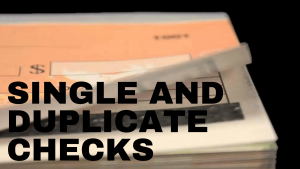Many of us have only heard about the word ‘checks’. But are you aware of the terms called single and duplicate checks. ? Well, if not, keep reading the entire article which will make you understand what are single and duplicate checks and what exactly is the difference between single vs duplicate checks.
There is a very thin line of difference between a single check and a duplicate check but it is really important to know that specific thin line of difference. Both of them serve the need and the end result of both the checks are the same i.e to pay someone.
If you issue a check you mean to pay someone from your account. In the case of a single check and duplicate check, the purpose will remain the same only, but the difference will be only of a carbon copy of that check.
It is really important to have an awareness about what kind of checks are available in the market and what exactly their roles are. Both single and duplicate checks have their own features and advantages.
To start with, let’s take a quick overview on the definition of both single and duplicate checks and also understand the difference between single vs duplicate checks
Definition of Single Checks and their features
A single check is a type of check-in in which varieties of checks come in single pages, without any duplicate check. Basically, they don’t need a carbon paper beneath a check, unlike duplicate checks.
If you are making any transaction using single checks, it would be considered incomplete in case the checks are torn or misplaced as you don’t have any proof of the check issued in the form of any carbon paper.
Single checks in a checkbook contain only paper checks which are to be filled and given to another person for payment
One of the main advantages of single checks is that it is lighter in weight so you can carry it easily anywhere. Also, the number of checks is higher in the checkbook than in comparison with duplicate checks.
There is no need to press hard while writing a check in case of single checks as there is no paper underneath.
The two-copy system is not applicable for single checks. Sometimes you can face a problem with single checks because you don’t have any proof to show somebody about the check issued.
And at the same time, you get the perks also of single checks. It will be inexpensive and again you will get more checks in the checkbook.
Now let’s understand what are duplicate checks what are the differences between duplicate vs single checks
What are Duplicate Checks and their features?
Duplicate checks are the type of checks which come along with a carbon copy beneath the original check for data records. Carbon copy, a thin sheet of paper is kept underneath the checks so that records can be maintained for later balancing the checkbook.
In duplicate checks, you get a checkbook that helps in maintaining a duplicate of each check you compose.
Duplicate checks are considered to be safer as you have evidence against each check you compose, unlike a single check.
There is no need to maintain a different record book for each check your issue as you already have a record just after you write a check so it is a hassle-free procedure while issuing a check.
The two-copy system is applicable in case of duplicate checks. It is safer than single checks. Many of them prefer duplicate checks after all who don’t prefer to get extra security.
In duplicate checks, to serve the needs there is no extra procedure to be done it is just similar to as single checks.
To know more in detail, let’s quickly jump on the details regarding duplicate check vs single check.
Difference between single check vs duplicate check
- Single checks do not come with a carbon copy feature, as the checkbook of single checks only comes with checks whereas, Duplicate checks come with a carbon copy feature i.e, you can find a plain piece of paper underneath a cheque.
- In a single check, there is no record maintained while drawing a check as there is no carbon paper underneath so the user himself is responsible to maintain records in another book while making a check whereas, In a duplicate check, when the user draws an original check, a copy is made on a piece of paper which is present underneath the check so, no need to maintain additional records.
- Single checks are less expensive in comparison to duplicate checks as the checkbook contains only single checks whereas, Duplicate checks are known to be quite expensive as the checkbook contains checks plus the carbon copy too along with every single check.
- Single checks are less heavier in comparison with duplicate checks as the weight of the checkbook consists only of single checks whereas, Duplicate checks are known to be heavier than single checks as the checkbook contains original checks along with the duplicate ones too.
- In the case of single checks, the user does not have to press hard while writing a check whereas,
In case of a duplicate check, the user has to press hard while writing a check so that it can be printed on that piece of paper also beneath it.
To sum up all, these were some of the common differences between single vs duplicate checks. There is no major difference between them as the end results are also the same in both cases. This overview is enough to make your confusion clear between single vs duplicate checks.











